- Prelude
- Editorial
- A time to Act
- Raja Ravi Varma: The painter who made the gods human
- Rabindranath as Painter
- Gaganendranath: Painter and Personality
- Abanindranath Tagore: a reappraisal
- Where Existentialism meets Exiledom
- Nandalal Bose
- Jamini Roy's Art in Retrospect
- Sailoz: The Inerasable Stamp
- Amrita Sher-Gil
- Calcutta's Best Kept Secret: The Marble Palace
- Art is Enigmatic
- A few tools to protect the French culture
- The exact discipline germinates the seemingly easiness
- Symbols of Monarchy, power and wealth the Turban Ornaments of the Nizams
- The Bell Telephone
- The Pride of India
- Tapas Konar Visualizing the mystic
- Theyyam
- Our Artists vs. their Artists
- Dragon boom or bubble?
- What Happened and What's Forthcoming
- Art Bengaluru
- Musings from Chennai
- Art Events Kolkata: May – June 2011
- Mumbai Art Sighting
- Previews
- In the News
ART news & views
Jamini Roy's Art in Retrospect
Volume: 3 Issue No: 18 Month: 7 Year: 2011
by Pranabranjan Ray
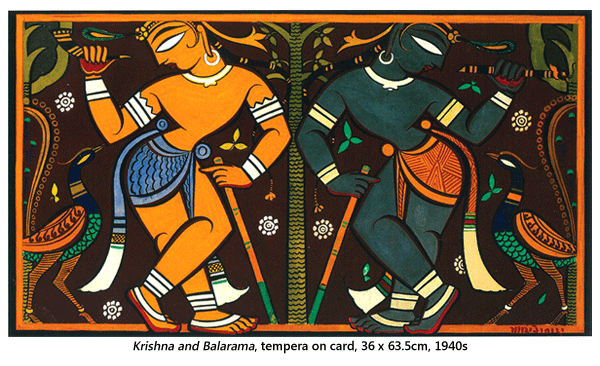
Rural born, Jamini Roy (born in 1887 at Beliator village in folkish art and craft-rich Bankura district) left the village, at the crucial age of sixteen in 1903, for art education at Calcutta's School of Art, is no more a significant fact for an aesthetic evaluation of the greatness of mature Jamini Roy painting, than a similar counter-fact of his sojourn back to the world of medieval terracotta-reliefs, rural patas and folk toys, 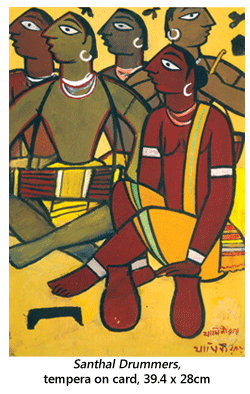 some eighteen years later.
some eighteen years later.
Jamini Roy need not also be remembered for the maximum illusion of likeness producing portraits, called the academic ones, which he did in oil on canvas, for meeting his cost of living in Calcutta. Of a little more interest are the more or less similar portraits he did after the first set, in tempera and in gouache in a la prima mode - retaining the brush-work marks, reminding one of the post-impressionist academic portraits painting. These brushwork marks, denoting but not simulating chiaroscuro, would take him towards surface 'modernism'.
Jamini Roy is an art historian's despair, for he never dated his works, and he was in the habit of often going back to his earlier themes and styles after time-gaps. Although most of his better seen post-Cezannesque Fauvist landscapes probably come from the forties, that is from the period when he had already touched the zenith of his signature style, there is strong chronological logic of their being first experimented with in the early twenties, and then abandoned for not being relevant to the artist's quest. These chromatically brilliant rich in texture free-Cezannesque landscapes would have made Jamini Roy an Indian Fauvist painter, but that was not what he was trying to achieve. However, he did learn his lessons in colour and texture on pictorial space which were to be integral elements in his signature style.
In the next developmental step, Jamini babu experimented with an Abanindranath-derived stylistics to integrate landscape and human figure, in a suggested landscape of land meeting sky in the horizon (in actuality a sky-colour area and a land-colour area), with a semi-silhouetted village-bell or a rural lad looming large in the foreground with her/his form (on being silhouetted). 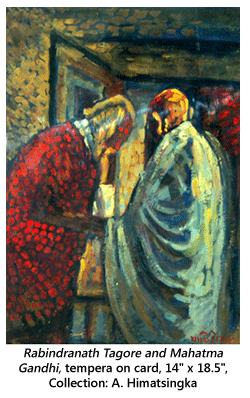 This sentimental short phase would have been a washout but for the lesson he learnt in transforming worldly three-dimensional space into pictorial space of colour-planes, and indicating figural-form by clearly contouring it. And there was third and more important latent element in this shift. Touched, probably, by Abanindranath's nationalism, Jaminibabu - for the first time realized the necessity of giving to the pictorial image a continuity clue and an identity. What else but a reference to the idyllic rural life could serve as a better instrument? Jaminibabu would soon pass over the period, retaining as he did, the three most important lessons he learnt from the experiment. It must, however, be admitted that on being infected by Abanindranath's nationalistic affliction, in 1921, Jaminibabu undertook a cultural journey back to re-discover the still living arts and crafts of rural Bengal, in terracotta reliefs, scroll patachitras, wooden patas and above all in folk toys (wooden and clay) of Bengal. The year 1921 in which Jaminibabu undertook his journey of re-discovery was the year of culmination of the first satyagraha launched by Gandhiji, the most important component of which was mobilization of masses around rural life as it was lived. This Gandhian movement undoubtedly had given Jaminibabu a solid substance for action on what till then was an Abanindranath Tagorean set of nationalistic aesthetic ideas which was not exactly Jaminibabu's cup of tea. Through the twenties both Abanindranath and Gandhiji remained with him, in his work.
This sentimental short phase would have been a washout but for the lesson he learnt in transforming worldly three-dimensional space into pictorial space of colour-planes, and indicating figural-form by clearly contouring it. And there was third and more important latent element in this shift. Touched, probably, by Abanindranath's nationalism, Jaminibabu - for the first time realized the necessity of giving to the pictorial image a continuity clue and an identity. What else but a reference to the idyllic rural life could serve as a better instrument? Jaminibabu would soon pass over the period, retaining as he did, the three most important lessons he learnt from the experiment. It must, however, be admitted that on being infected by Abanindranath's nationalistic affliction, in 1921, Jaminibabu undertook a cultural journey back to re-discover the still living arts and crafts of rural Bengal, in terracotta reliefs, scroll patachitras, wooden patas and above all in folk toys (wooden and clay) of Bengal. The year 1921 in which Jaminibabu undertook his journey of re-discovery was the year of culmination of the first satyagraha launched by Gandhiji, the most important component of which was mobilization of masses around rural life as it was lived. This Gandhian movement undoubtedly had given Jaminibabu a solid substance for action on what till then was an Abanindranath Tagorean set of nationalistic aesthetic ideas which was not exactly Jaminibabu's cup of tea. Through the twenties both Abanindranath and Gandhiji remained with him, in his work.
Yet, it was not exactly in the twenties that Jamini Roy had arrived at the threshold of his signature style. Another little known event had to happen towards the end of the twenties, or at the beginning of the thirties, to act as catalyst. The novelist Tarasanker Bandyopadhyay, who was a neighbour of both Jamini Roy and the anthropologist and Gandhian, Nirmal Kumar Bose, writes in his autobiography that some time at the beginning of the thirties, Nirmalbabu had gifted a few pata paintings of one of the last generation of the famous Kalighat patuas to both Jamini Roy and Nandalal Bose, making them both excited and happy.  In Jaminibabu's case the final break-through came through a study of these and in Nandalal's case a study of these led to the Haripura murals/posters. My teacher Nirmalbabu did, in the sixties, indeed confirm that he introduced the two masters to Kalighat pata. However, one should not come to the conclusion as one is apt to do, that once he had found this source it became Jamini Roy's only visual-linguistic source of appropriation. Far from that, Jamini Roy appropriated only a few elements from the Kalighat pata tradition, as he did with other Bengal folk art traditions. But what he appropriated from the Kalighat tradition he transformed those into cardinal visual-linguistic component of his personal style. Two of these were: one, the curvilinear (of elliptical or parabolic propensity) band-like contour line to define the outline of an image, and two, juxtaposition of the concavilinear and the convexilinear contoured area to connote the volume of the area without chiaroscuroistically denoting it. And the third, colouring all areas of a painting flatly, without resorting to chiaroscuro. At the same time, he totally rejected the irregular configuration of images seen in Kalighat pata for visual narrative effect, signaling his rejection of narration in visual art - a very 'modernist' fetish per se.
In Jaminibabu's case the final break-through came through a study of these and in Nandalal's case a study of these led to the Haripura murals/posters. My teacher Nirmalbabu did, in the sixties, indeed confirm that he introduced the two masters to Kalighat pata. However, one should not come to the conclusion as one is apt to do, that once he had found this source it became Jamini Roy's only visual-linguistic source of appropriation. Far from that, Jamini Roy appropriated only a few elements from the Kalighat pata tradition, as he did with other Bengal folk art traditions. But what he appropriated from the Kalighat tradition he transformed those into cardinal visual-linguistic component of his personal style. Two of these were: one, the curvilinear (of elliptical or parabolic propensity) band-like contour line to define the outline of an image, and two, juxtaposition of the concavilinear and the convexilinear contoured area to connote the volume of the area without chiaroscuroistically denoting it. And the third, colouring all areas of a painting flatly, without resorting to chiaroscuro. At the same time, he totally rejected the irregular configuration of images seen in Kalighat pata for visual narrative effect, signaling his rejection of narration in visual art - a very 'modernist' fetish per se.
It is not that, once Jaminibabu had arrived at what he was seeking, 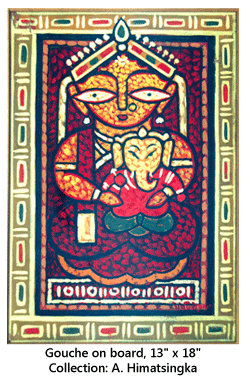 by traversing the path the Western art had traversed from academic illusionistic naturalism to Fauvism to abstract art of some kind, Jamini Roy stayed put and did not do much experimentation. Indeed, he did quite a wide ranging research from choice of pictorial surface offering variations in textures to frame-image spatial relationship and the linear determination of extra-painterly identity of the human images posited on pictorial surface. However, in spite of experiments with configuration of negative space i.e. background and positive space i.e. image-occupied space, linearly divided pictorial spatial areas and variations indicated residual worldly identity of the images, certain formal visual-linguistic concerns remained constant through half of the thirties to the first couple of years of the seventies and became hallmark features of Jamini Roy's style. Let us first enumerate these and then discuss about their effects.
by traversing the path the Western art had traversed from academic illusionistic naturalism to Fauvism to abstract art of some kind, Jamini Roy stayed put and did not do much experimentation. Indeed, he did quite a wide ranging research from choice of pictorial surface offering variations in textures to frame-image spatial relationship and the linear determination of extra-painterly identity of the human images posited on pictorial surface. However, in spite of experiments with configuration of negative space i.e. background and positive space i.e. image-occupied space, linearly divided pictorial spatial areas and variations indicated residual worldly identity of the images, certain formal visual-linguistic concerns remained constant through half of the thirties to the first couple of years of the seventies and became hallmark features of Jamini Roy's style. Let us first enumerate these and then discuss about their effects.
That the two cardinal visual-linguistic elements of Jaminibabu's paintings are lines and two-dimensional pictorial surface is a simplistic truism. A slightly better truism is that he used the line both to divide the pictorial surface into negative space and image-filled space of balanced proportions and to enclose the images as contour lines. Of greater significance is the quality of lines in Jaminibabu's paintings. The lines that divide the surface of his paintings as contour/image-defining lines are more bands than lines. And the band-like thin-to-thick-to-thin massey, gently gliding curvilinear lines of parabolic propensity often simulates vegetal/floral linear-pattern, thereby endowing the images with organism semblance. Can we trace the root of this in the collective unconscious of a rural-agrarian culture from which Jaminibabu came? We should not, however, hasten to categorise Jaminibabu's art with what Wilhelm Worringer had termed organic as opposed to geometric. Jaminibabu's works defy this western binary. If we look closely at his images, which are basically flat and two dimensional, these reveal themselves as agglomerations of geometric shapes. Due to their being defined by the kind of contour lines, as has just been enumerated, these do not appear as geometric as these really are. This, precisely is, one of the reasons that makes Jamini Roy a 'modern' Indian who cannot be contained within the Eurocentric concept of 'modern'. More about this will come later.
Due to their being defined by the kind of contour lines, as has just been enumerated, these do not appear as geometric as these really are. This, precisely is, one of the reasons that makes Jamini Roy a 'modern' Indian who cannot be contained within the Eurocentric concept of 'modern'. More about this will come later.
Another very significant function of the band like thin-to-thick-to-thin gently curving contour lines, in their flowing patterned laying bind the configured negative and image spaces in vegetal rhythm. This type of rhythmic patterning of floromorphic lines camouflage the perfectly geometric comprising shapes of the images (oblong, parabolic, hyperbolic, roundish and trapezoids etc.) and present these as organism entities. Being agglomerations of basically geometric comprising shapes, the vegetal contours of which turn those into organism entities, Jamini Roy's indicated images tend to contain and strike a balance between geometric and organismic. This balance striking repose is a significant feature of Jamini Roy's art. Rhythm plays the prime role in the striking of balance between negative and positive space, geometric and organismic approach to delineation and finally in the distribution of luminosity of colour areas. The cumulative resultant effect of the visual-linguistic arrangements into style, inevitably gives to his paintings a balanced equilibrium, of background space and image space, geometrically divided space and organism endowed by contour lines and, warm and cool, bright and sombre colour areas. The regular and predictable surface sequencing of these visual-linguistic elements further heighten the sensation of balanced equilibrium, making his art poised, cool and classicist,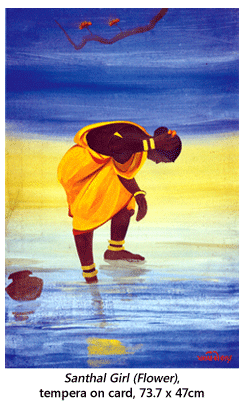 and consequently devoid of the vital élan.
and consequently devoid of the vital élan.
Jaminibabu was perhaps aware that the perfect painterly construction of painting he was heading to would not do with beholders; he therefore endowed the flat areas with non-chairoscuroistic brushwork textural embellishments and made his contour lines a little less regular than these apparently are. These little deviations from regular application make his pre-forty three paintings less decorative and livelier than the later paintings where colour-areas are flatter and lines almost mechanically curvilinear.
We have so far been talking only about the formal and constructional aspects of Jamini Roy's art, as these should, particularly in his case, be given a priority. Images, with known cultural and social associations especially with folk life of the rural agrarian Bengal, have immediate presence in Jaminibabu's art. Youthful peasant housewives and rural workforce, Krishna Balaram and Subhadra, Krishnaleela, Rama Lakshmana Seeta and other characters from the Ramayana, Jesus Christ Mary Joseph, the nativity, the last supper, the crucifixion and the resurrection of Christ, the Kamadhenu cow, bovines of gostha-leela and cats fishes lobsters etc. of Kalighat pata and sitting birds of the Santal wall decoration are the immediate images of Jaminibabu's painting. Jamini Roy even painted episodes from the Ramayana, over and over again, in the forties and the fifties. Not to mention of the paintings not based upon known narratives, even those based upon known mythical narratives appear as disjointed scenes of events frozen in time, just as his Krishna's and gopinis in dancing postures, look frozen at a moment in perfectly balanced poises, with each part of a moving human body balancing another part. This lesson about the point of equilibrium in a time-series,  Jamini Roy must have learnt from studying the iconology of dancing Nataraja. Even if Jaminibabu depended on iconological marks, like sarees on bare bodies with a ghomta over head for a rural housewife, bare-bodied men in loin cloth with implements of production, blue bodied Krishna with a flute, Balarama with a plough, Rama with his bow alongside Seeta and Lakshmana, Subhadra and Seeta invariably accompanied by Krishna-Balaram and Rama-Lakshmana, from gestural and postural interactional stances, spatial placement of character-images, and gazes of the imaged-characters, in Jaminibabu's painting it is well-nigh impossible to formally differentiate images based on real life from those based on myths, and images based on one myth and another myth. Simply for the reason that Jamini Roy was never too interested in narratives (the only exceptions have been Jaminibabu's paintings based on myths and legends centering the life and death of Jesus Christ. Without being moved by a feeling of deep empathy for the subject matter these paintings could not have been painted. Interestingly, the visual-linguistic means for the visual objectification of this empathy was derived not so much from the Bengal folk art as from another Fauvist, albeit a Christian painter -George Rouault. Let us not dwell so much on the Fauvism inspired language of Jamini Roy's Christ-paintings, for we know that he had half-a-life-long not so secret love affair with varieties of Fauvism).
Jamini Roy must have learnt from studying the iconology of dancing Nataraja. Even if Jaminibabu depended on iconological marks, like sarees on bare bodies with a ghomta over head for a rural housewife, bare-bodied men in loin cloth with implements of production, blue bodied Krishna with a flute, Balarama with a plough, Rama with his bow alongside Seeta and Lakshmana, Subhadra and Seeta invariably accompanied by Krishna-Balaram and Rama-Lakshmana, from gestural and postural interactional stances, spatial placement of character-images, and gazes of the imaged-characters, in Jaminibabu's painting it is well-nigh impossible to formally differentiate images based on real life from those based on myths, and images based on one myth and another myth. Simply for the reason that Jamini Roy was never too interested in narratives (the only exceptions have been Jaminibabu's paintings based on myths and legends centering the life and death of Jesus Christ. Without being moved by a feeling of deep empathy for the subject matter these paintings could not have been painted. Interestingly, the visual-linguistic means for the visual objectification of this empathy was derived not so much from the Bengal folk art as from another Fauvist, albeit a Christian painter -George Rouault. Let us not dwell so much on the Fauvism inspired language of Jamini Roy's Christ-paintings, for we know that he had half-a-life-long not so secret love affair with varieties of Fauvism). 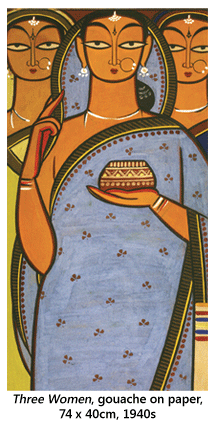 To go back to Jaminibabu's object-images once again, by contouring a wide variety of human, animal and bird images with lines of similar character, stylistically delineating their physical features similarly and painting them flatly, he reduces them to agglomerations of a shape, albeit with iconographic identification marks. Even when these denotatively indicate, these do not connote phenomenal stories. The positing of such internally balanced indicator images on plain surface in rhythmic regularity, make his paintings design-like with no phenomenal content, even when these have distant objective references. Even with object-indicators Jamini Roy's paintings are purist painting. The balanced equilibrium of purely visual elements exude from them a far from maddening world calmness.
To go back to Jaminibabu's object-images once again, by contouring a wide variety of human, animal and bird images with lines of similar character, stylistically delineating their physical features similarly and painting them flatly, he reduces them to agglomerations of a shape, albeit with iconographic identification marks. Even when these denotatively indicate, these do not connote phenomenal stories. The positing of such internally balanced indicator images on plain surface in rhythmic regularity, make his paintings design-like with no phenomenal content, even when these have distant objective references. Even with object-indicators Jamini Roy's paintings are purist painting. The balanced equilibrium of purely visual elements exude from them a far from maddening world calmness.
The personal history of the development of Jamini Roy's art, as we have already noticed, followed the path of development of occidental modernism up to a point. Gandhian and Tagorean ideas then intervened to change his trajectory a bit. He with a classicist mentality of giving importance to the communication function of art, Roy found in the visual-linguistics of the living traditions of the folk arts and crafts of Bengal resources which could be appropriated, transformed and used to communicate with potential spectators. Thus was born a 'modernist' Indian individualist artist's art, in a language format derived from the quintessential structure of folk art of Bengal. A highly logical inference led Jaminibabu to arrive at this personal solution of the vexed question of visual character of 'Indian modern art'. He had probably argued, that if the autonomy-seeking 'modernism' of the Western artists had led them to some kind of formalism in which the phenomenal image was inconsequential, and yet be besotted with either the fetish of geometry of industrial existence or the industry-negating primordial organicity, what then was wrong with an artist coming from the rural-agrarian background,  who unlike his western counterpart was not alienated from that life, to fall back on the store house of familiar visuals for formalistic appropriations. Thus was born an object-based purist/formalist art, true to the world of visual experience possible in an under-developed colonial country.
who unlike his western counterpart was not alienated from that life, to fall back on the store house of familiar visuals for formalistic appropriations. Thus was born an object-based purist/formalist art, true to the world of visual experience possible in an under-developed colonial country.
Jamini Roy's rural simplicity, in retrospect, appears to have been more a cultivated quality than real. The development of his own aesthetic parameters of creative action followed exactly the trajectory of Euro genetic 'modernism'. The change of trajectory of Jaminibabu's art praxis too had a solid logical base. If 'modernism' in art was an action-oriented movement to create an autonomous system of art, with an independent visual-language, and if such a 'modernism' practiced in the West had sprung there from the spring board of specifically Western visual culture and experience, why should not then, an autonomy seeking 'modernist' Indian art take off from the storehouse of memory of its own visual forms. For Jaminibabu it was not only an apologetic reasoning. He, with a latent belief in classicist values, believed that to reach out to a wide spectrum of spectators and appreciators, a linguistic continuity was sine-qua-non for even the most individualist artist. With such reasoning, Jaminibabu created an individual Indian 'modernist' artist's unique kind of art, with an unmistakably Indian identity of a kind. That precisely is the reason why Jamini Roy needs to be celebrated as 'modernist' Indian artist, of highest significance, even if his art was not contextually as relevant as some of his contemporaries and juniors. Significant though as non-abstract purist art with 'Indian' visual association, any reference to Indian life and the hopes and anxieties the life inevitably generated, is totally absent from Jamini Roy's art. Jamini Roy's is a self-contained autonomous art, at peace with itself.
